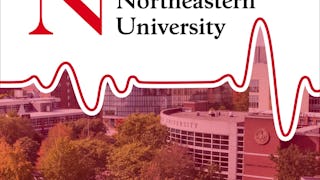This course is best suited for individuals currently in the healthcare sector, as a provider, payer, or administrator. Individuals pursuing a career change to the healthcare sector may also be interested in this course.

Genießen Sie unbegrenztes Wachstum mit einem Jahr Coursera Plus für 199 $ (regulär 399 $). Jetzt sparen.

Empfohlene Erfahrung
Was Sie lernen werden
Explain how the delivery of healthcare in the U.S. is organized and financed
Compare the American healthcare system to those existing in other countries
Identify emerging trends affecting healthcare delivery, including the American population, technologies, genetic testing, and patient engagement
Kompetenzen, die Sie erwerben
- Kategorie: Payment Systems
- Kategorie: Public Health
- Kategorie: Health Care
- Kategorie: Medical Billing
- Kategorie: Value-Based Care
- Kategorie: Health Systems
- Kategorie: Pharmaceuticals
- Kategorie: Medicaid
- Kategorie: Health Policy
- Kategorie: Healthcare Industry Knowledge
- Kategorie: Health Care Administration
- Kategorie: Drug Development
- Kategorie: Tax Laws
- Kategorie: Health Disparities
- Kategorie: Medicare
Wichtige Details

Zu Ihrem LinkedIn-Profil hinzufügen
Erfahren Sie, wie Mitarbeiter führender Unternehmen gefragte Kompetenzen erwerben.

In diesem Kurs gibt es 4 Module
In this module, we will discuss the basic mechanics of paying for volume and how it affects physician payment. Looking ahead, in the U.S., traditional payment approaches for healthcare providers, such as fee-for-service and per diem payments, are being slowly phased out due to concerns about excessive and unnecessary utilization of healthcare services contributing to rising healthcare costs. Additionally, the US healthcare system is undergoing a slow shift from paying providers for volume to paying them for value, which means they are rewarded or penalized based on their quality of care and efficiency.In this module we will explore these traditional payment arrangements as well as the new methods and developments. We will examine the benefits and drawbacks to the different methods and how they affect provider performance.
Das ist alles enthalten
8 Videos9 Lektüren5 Aufgaben2 Diskussionsthemen
In this module, we will now focus our attention on the diffusion of pricing and prescription medications in the U.S. Prescription drugs account for over 10% of total healthcare spending in the U.S. and are increasingly important for managing chronic conditions. However, the regulatory process for approving new drugs has long been a source of controversy, with stakeholders contending it is inefficient and contributes to rising drug costs. To better understand these issues, we will explore how drugs are developed and regulated.We will also continue on in our exploration of initiatives addressing the cost and value of prescription drugs in this module. Rising drug costs have been a major concern for both the private and public sectors, with initiatives ranging from value-based contracts to federal and state laws aimed at negotiating drug prices and limiting out-of-pocket expenses for patients. While the impact of many of these initiatives is yet to be evaluated, the hope is that they will ultimately result in affordable access to prescription drugs for all Americans.
Das ist alles enthalten
5 Videos3 Lektüren5 Aufgaben1 peer review
Healthcare financing and delivery vary across the globe, with different approaches to public and private sector involvement, as well as universal health coverage. The U.S. has a mixed model with both public and private sector involvement, but lacks universal coverage, while other countries rely predominantly on either the public-or private-sector with varying levels of out-of-pocket spending. In this module, we will explore the key differences between the U.S. healthcare system and the healthcare systems of other countries. We will examine the advantages and disadvantages of various healthcare systems models and evaluate the performances of these systems. How do you feel currently about your quality of care? Perhaps learning about different models of healthcare delivery around the world will give you a new perspective.
Das ist alles enthalten
4 Videos4 Lektüren4 Aufgaben1 Diskussionsthema
In this module, we will examine the tax-exempt status of nonprofit hospitals in the U.S., which generate millions in annual revenue but are exempt from paying income, property, and sales taxes. We will also discuss the qualifications that allow these hospitals to enjoy this favorable tax treatment, and the community benefits they are expected to provide in return. Nonprofit hospitals in the U.S. face a unique challenge of providing community benefits while also competing in a highly competitive market for healthcare services. However, research has found that charitable spending can be a source of competitive advantage, leading to increased customer loyalty and financial benefits. We will reflect on the tax exemptions and community benefits as well as the social accountability for healthcare delivery more in this module.
Das ist alles enthalten
8 Videos6 Lektüren5 Aufgaben1 peer review
Dozent

Mehr von Healthcare Management entdecken
 Status: Vorschau
Status: VorschauNortheastern University
 Status: Kostenloser Testzeitraum
Status: Kostenloser TestzeitraumStanford University
 Status: Kostenloser Testzeitraum
Status: Kostenloser Testzeitraum Status: Vorschau
Status: VorschauUniversity of Glasgow
Warum entscheiden sich Menschen für Coursera für ihre Karriere?




Häufig gestellte Fragen
To access the course materials, assignments and to earn a Certificate, you will need to purchase the Certificate experience when you enroll in a course. You can try a Free Trial instead, or apply for Financial Aid. The course may offer 'Full Course, No Certificate' instead. This option lets you see all course materials, submit required assessments, and get a final grade. This also means that you will not be able to purchase a Certificate experience.
When you purchase a Certificate you get access to all course materials, including graded assignments. Upon completing the course, your electronic Certificate will be added to your Accomplishments page - from there, you can print your Certificate or add it to your LinkedIn profile.
Yes. In select learning programs, you can apply for financial aid or a scholarship if you can’t afford the enrollment fee. If fin aid or scholarship is available for your learning program selection, you’ll find a link to apply on the description page.
Weitere Fragen
Finanzielle Unterstützung verfügbar,
¹ Einige Aufgaben in diesem Kurs werden mit AI bewertet. Für diese Aufgaben werden Ihre Daten in Übereinstimmung mit Datenschutzhinweis von Courseraverwendet.





